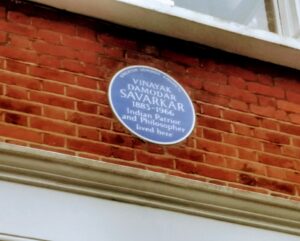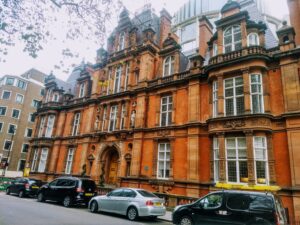
Vinayak Damodar Savarkar had pledged a sacred vow to embark on the armed, revolutionary struggle for independence of India. After Nashik and Pune his next karmabhoomi was London and the centre of the struggle was India House. This article delves upon the revolutionary works of Savarkar in London in general and India House in particular. The focus of the article is how Savarkar contributed to the Indian Nationalist Movement through India House and further how he took charge of and used the platform to pursue his vision. Savarkar’s years in London and in the India House are etched as exemplary milestones in India’s march towards Independence.
Valentine Chirol, a British journalist described it the best – “India House is the most dangerous place outside India”. Its founder Shyamji Krishna Verma, a lawyer by profession and revolutionary by heart, was particular in his choice for who was admitted to the ‘order’ he intended to establish through India House. Secret Society was the call of the hour. In the name of lodging facility of Indian students in London, Mr. Verma was in fact recruiting promising minds to be used in the struggle in the form of students. To be inducted, students needed recommendations of notable names of Indian National Movement. None other than Mr. Bal Gangadhar Tilak had endorsed the name of Savarkar.
In a very short time after its formation, India House was on board with an assemblage of some notable inmates which included MPT Acharya, Lala Hardayal, VVS Aiyar, P M Bapat (Senapati Bapat), V N Chaterjee and Madan Lal Dhingra. Along with Savarkar, all of them went on to become big names in Indian Struggle for Independence.
Savarkar had taken a center stage in the India House and the revolutionary activities in Europe. Through, speeches, writings and forums Savarkar intended to initiate others into the ‘order’. It’s here that he decided to write the political biography of Italian revolutionary Giuseppe Mazzini which became an instant hit. Over 2000 copies of the book were printed, distributed and well-read in India and Europe. Among his other works which he wrote to advocate revolutionary means for Indian Independence, was the notable Indian War of Independence – a book which was eventually banned by the British. It was Savarkar’s pen that did the justice to the uprising by calling it India’s war of Independence to which Britishers often underrated it by calling a mere ‘Mutiny’. Savarkar also organized events to commemorate the 50th Anniversary of this event that had shook the foundations of British Colonial Empire. Many other events were also celebrated wherein Savarkar had ensured the intellectual grooming of the congregation, inspire them and made them ready for their endeavors of aiding their ultimate aim- Political Freedom of their motherland.
Back in India British chalked out a plan for the Partition of Bengal and there were fierce anti Partition Movements not only in Bengal but also in Bombay Presidency and Punjab. India is spread both in the length and in breadth. If Bengal was eastern shores, Bombay was Western end. And erstwhile Punjab was thousands of miles North West. But the ‘tyranny of distance’ never existed in the Nationalist leaders of those days who were fired up for the bigger cause. While Bipin Chandra Pal lead the way in Bengal, Lala Lajpat Rai held the batten in Punjab and none other than Bal Gangadhar Tilak lead the front in Bombay Presidency. Lal-Bal-Pal symbolized the inter-regional unity in India.
They say the world is round and small. So it was for Savarkar and India House. Somehow these distant states in India were gathering together in India House too. Madan Lal Dhingra a Punjabi, had conspired with a Marathi Savarkar to kill Lord Curzon, on his return to England, enraged by the events of his involvement in Partition of Bengal and sowing the seeds of division back into their motherland. Dhingra had failed into his attempt. Another namesake, Sir Curzon Wylie Aide De Camp to the Secretary of State for India, was entrusted with the duty of curbing the menace of the suspected activities in India House. Curzon Wylie had written to the Gray’s Inn, Bar Institute where Savarkar was pursuing his legal studies, to reconsider his induction into the Bar. It is believed that Wylie had also travelled to France enquiring Savarkar’s link to then then absconding revolutionaries in France Shyamji K Verma, Madam Cama and Sardar Singh Rana. Curzon Wylie posed a big threat to the activities of India House.
Meanwhile, Savarkar had moved out of India House and occupied Bipin Chandra Pal’s residence at Sinclaire Road, London. Same names keep reappearing in the whole saga, the world was too small, indeed. Dhingra also had moved out in an apartment in Ledbury Road, London. On July 01, 1909 Dhingra finally shot Curzon Wylie at Imperial Institute at point blank range. Curzon Wylie was a good friend of Dhingra’s father, who was high ranked British Government servant back in India and who detested his son’s nationalistic inclinations.

(This is present Caxton Hall where Savarkar opposed the resolution to condemn Madan Lal Dhinga)
This was the first ever incidence wherein an Indian had spilt the blood of a British national on the British soil. The whole of England shook. Madan Lal’s father, Sahib Singh Dhingra disowned him in writing to Lord Morley, then Secretory of States for India. His 2 brothers, who also resided in London in those days, disowned him. On 5th July, a meeting of Indians residing in England assembled in Caxton Hall. Here all Indians raised hands to pass the resolution to abhor the assassination of Curzon Wylie by Madan Lal Dhingra, and almost were about to pronounce the passage of resolution ‘unanimous’, one voice thundered saying ‘NOT UNANIMOUSLY’. It was indeed Vinayak Damodar Savarkar ho had opposed the resolution. Savarkar ensured that the disagreement to Dhingra’s insult is registered, but in the process Savarkar made a compelling point that the battlefield for India’s independence is restricted not just to India. India House and its activities were fledging towards its eventual aim. In the next part of the article we will discuss how initiatives of India House reflected in larger efforts by different revolutionaries across India.
Sources:
View Expressed are of the author’s and does not nexessarily reflect official position of Mimamsa – An Indic Inquiry
Author : Ameya Ranade
Ameya is Engineer by profession and writes frequently on Indian history, religion and philosophy.

छान लिहिलंय अमेय😊
अभ्यास असाच सुरु ठेव